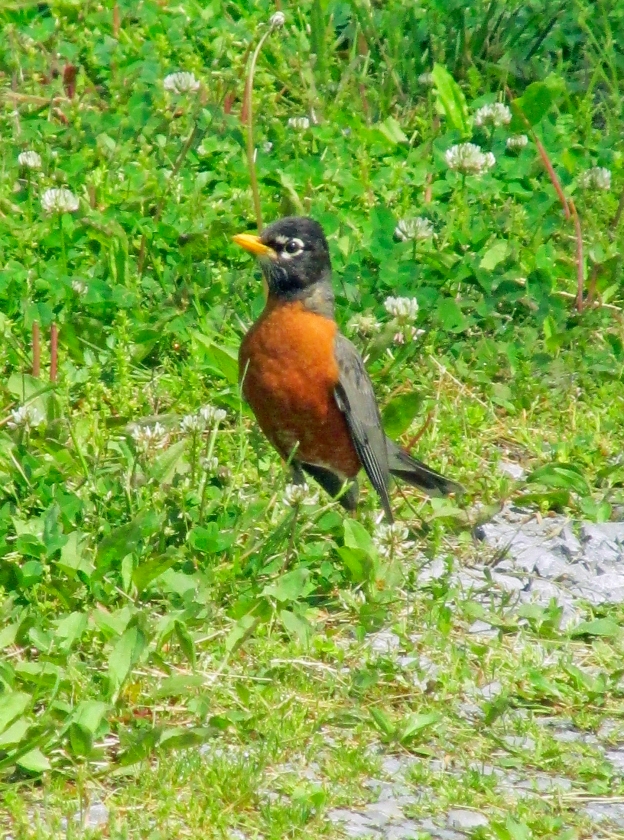
Photo by Peter Pearsall/ USFWS • An American robin at Cape Mears NWR perches on a sign. Robins have long been a beloved sign of spring’s return in North America.
I don’t think I’m alone in doing what I can to speed along the process of spring’s arrival. The arrival of flocks of American robins has long been a dependable signal coinciding with the shifting of the winter season into spring. This year, the robins appeared almost overnight. One day, I didn’t notice any robins; on the next, they were everywhere I looked.
The American robin is known by the scientific name Turdus migratorius, which can be translated as “migratory thrush.” Indeed, this well-known American bird is related to other thrushes, including the Eastern bluebird, wood thrush and veery. The relationship to other thrushes is quite visible in young birds, which display a spotted breast until they mature and acquire the familiar red breast associated with robins.
One of the first things robins do after returning each spring is switch their diet. Instead of focusing heavily on fruit, robins will hunt for invertebrate prey items, including insects and earthworms once warming temperatures make these creatures widely available for the hungry birds. Forming large flocks as they migrate, dozens of these restless birds can descend on a lawn. Hopping through the short grass, these sharp-eyed birds can spy the slightest movement from an insect, grub or worm concealed in the grass. They forage efficiently and diligently.
The website, Journey North, focuses on tracking the migration of various species of wildlife, relying on the contributions of “citizen scientists” to help with its mission of conservation and protections of migratory species.
The website also offers some interesting facts about American robins. According to Journey North, robins are bursting to sing once they return each spring.

Photo by Bryan Stevens • American robin sitting on its nest in the shelter of a side of a bridge spanning the Doe River in Elizabethton, Tennessee.
“Robins sing when they arrive on their breeding territories. Sometimes robins even sing in winter flocks, due to surging hormones as the breeding season approaches,” the website states. “However, in the majority of cases, robins really do wait to sing until they have reached their territory.”
Once robins start singing each spring, it’s also the time when the large flocks break up. When male robins sing, it is to proclaim and protect territories, so the attractiveness of a flock is different for a robin depending on whether the season is winter or spring.
The poet Emily Dickinson made note of this penchant for song that robins express with such enthusiasm upon their return each spring in her poem “The Robin,” writing these lines:
“The robin is the one
That interrupts the morn
With hurried, few, express reports
When March is scarcely on.”
Even in Dickinson’s time, the month of March was associated with the return of the American robins to towns, yards and gardens across New England and the rest of the United States.
There are 82 other species in the genus, which ranges not only in the Americas, but Europe, Asia, Africa and Australia, as well. Some of the American robin’s fellow genus members include the olive thrush, the bare-eyed thrush, pale thrush, great thrush, black-billed thrush and cocoa thrush.
When the first European settlers arrived in North America, the robin was still a bird living in the forests. Robins proved incredibly capable of adapting to the presence of humans. Soon enough, these once shy forest birds began to frequent lawns and city parks. The robin soon became one of America’s most popular songbirds. Three states — Connecticut, Michigan and Wisconsin — have conferred official state bird status on the American robin.
Robins begin nesting almost as soon as they return each spring. Nesting success in a previous season instills fidelity to the location where the birds nested, resulting in many robins returning to the same nesting area year after year.
According to the Tennessee Watchable Wildlife website, American robins usually raise two broods of young during their nesting season in the Volunteer State. Many start nesting in late winter, but peak egg laying is in mid-April. The spring months are also when robin pairs will be kept busy finding enough earthworms and insects to feed a nest filled with three to five hungry young.
Although some robins invariably spent the entire winter season in the region, it is still a welcome sight to see migrating flocks of these birds return every February and early March. The sudden resurgence of the American robin each spring is a reminder that another winter will soon be history. I know I’m always pleased to welcome them back.
















